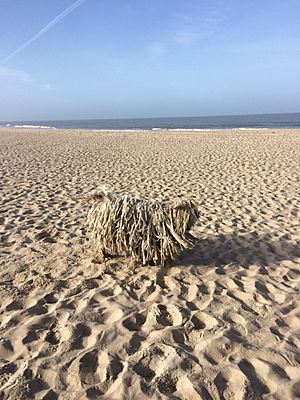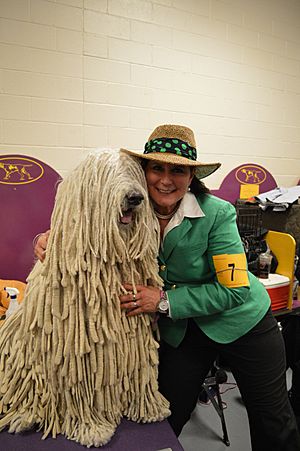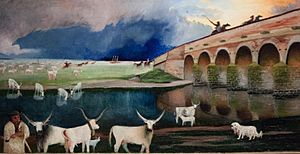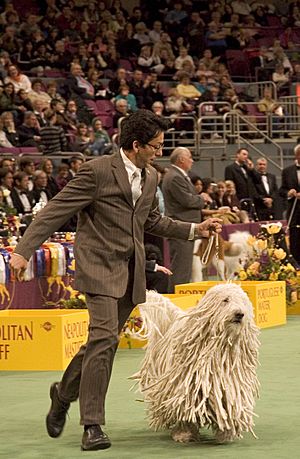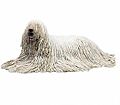Komondor facts for kids

Komondor
|
||||||||||||||||||||||||||
| Other names | Hungarian Commonmop Hungarian Sheepdog Mop Dog |
|||||||||||||||||||||||||
|---|---|---|---|---|---|---|---|---|---|---|---|---|---|---|---|---|---|---|---|---|---|---|---|---|---|---|
| Origin | Hungary | |||||||||||||||||||||||||
|
||||||||||||||||||||||||||
| Domestic dog (Canis lupus familiaris) | ||||||||||||||||||||||||||
The Komondor, also known as the Hungarian sheepdog, is a large, white dog breed. It comes from Hungary and has a unique, long, corded coat. These dogs are a type of livestock guardian dog. This means they are bred to protect farm animals.
Sometimes people call them 'mop dogs' because of their special coats. Komondors are strong dogs with a natural instinct to guard animals and property. The Cumans brought the Komondor breed to Europe a long time ago. In Hungary, the Komondor is considered a national treasure. It is protected to make sure its special qualities are kept safe.
Contents
What Does a Komondor Look Like?
The Komondor has a very long, thick, and white coat. It looks like dreadlocks or a mop. This coat can be about 20 to 27 centimeters long. It is one of the heaviest coats in the dog world.
When a Komondor is a puppy, its coat is soft and fluffy. As the puppy grows, the coat becomes wavy and starts to curl. The full adult coat forms naturally over about two years. It is made from the soft undercoat and the coarser outer coat. These combine to create the unique cords or tassels.
Sometimes, you need to help separate the cords. This stops the dog's fur from becoming one big tangled mess. The cords get longer as the coat grows. Komondors do not shed much once their cords are fully formed. The main shedding happens when they are puppies, before the dreadlocks appear.
Komondors are born with only white fur. But if a working Komondor is outside a lot, its coat might get dirty. It can look off-white if it is not washed often. The thick coat traditionally helps protect the Komondor from wolf bites. The bites usually cannot get through the dense fur. After a bath, a Komondor's coat can take about two and a half days to dry.
Komondor Temperament: How They Act
Komondors are made for guarding livestock. Their personality is like most guardian dogs. They are calm and steady when everything is normal. But if there is trouble, they will bravely protect their animals. They were bred to think and act on their own. They can make decisions by themselves.
Komondors are loving with their own family. They are gentle with children and family friends. They might be careful around strangers at first. But they will accept new people if it is clear there is no danger. They naturally protect their family, home, and belongings. Komondors get along well with other family pets. They often protect them too. However, they do not like animals that trespass. They are not good dogs for living in an apartment.
These dogs are very watchful. They often rest during the day, keeping an eye on their surroundings. But at night, they are always moving. They patrol their whole territory. They will usually knock down intruders and hold them until their owner arrives. Old Hungarian Komondor breeders used to say something interesting. They said an intruder might get onto a Komondor's property, but they would not be allowed to leave.
What Komondors Are Used For
The Komondor breed has a natural instinct to guard. They are very good at protecting livestock. Komondors are athletic dogs. They are fast and strong. They will leap at a predator to scare it away or knock it down. They can successfully guard sheep against wolves or bears. They are big, strong dogs with a thick, protective coat. This coat protects them from wild animals, bad weather, and plants.
Their coat also looks like a sheep's wool. This helps them blend in with a flock of sheep. It gives them an advantage when predators like wolves attack. The Komondor is a popular livestock guardian dog in the United States. Many farmers use them to protect their sheep and goats. They guard against predators like coyotes, cougars, and bears.
Training Your Komondor
Komondors are large, powerful, and fast dogs. Because of this, it is very important to train them well. If they are not trained, they could be dangerous to others. Komondors usually learn well if training starts early. The best time is between 4 and 8 months old.
A Komondor can become stubborn if it gets bored. So, training sessions should be fun and exciting. Always praise your dog when it does well. You also need to be consistent and fair with corrections. If a Komondor gets away with bad behavior, it will think that behavior is okay. So, you must correct them consistently, even when they are young puppies. This helps them become well-behaved adults.
Socialization is also super important. A Komondor puppy should meet new situations, people, and other dogs. This helps them learn to be comfortable. Komondors are natural guard dogs. If they are not socialized properly, they might act too aggressively. This can happen when they meet new situations or people.
With the right home and care, a Komondor is a responsible and loving dog. They are loyal and calm, but not lazy. Just like with any dog breed, their personalities can differ. So, you should tell a breeder what you are looking for. An experienced breeder can help find a puppy that fits your needs. Some might be happier as independent livestock dogs. Others might want to please more and be good family pets.
When Komondors become teenagers, their personality can change. Their eating habits, how easy they are to train, and their general attitude might shift. In some countries, laws require certain dog breeds to wear a muzzle in public. Romania is the only country that requires Komondors to be muzzled.
Images for kids
See also
 In Spanish: Komondor para niños
In Spanish: Komondor para niños


